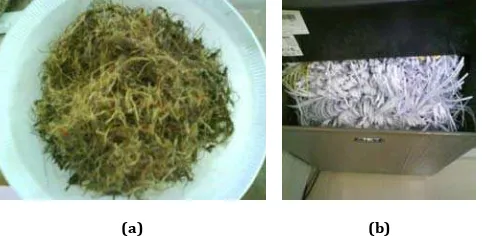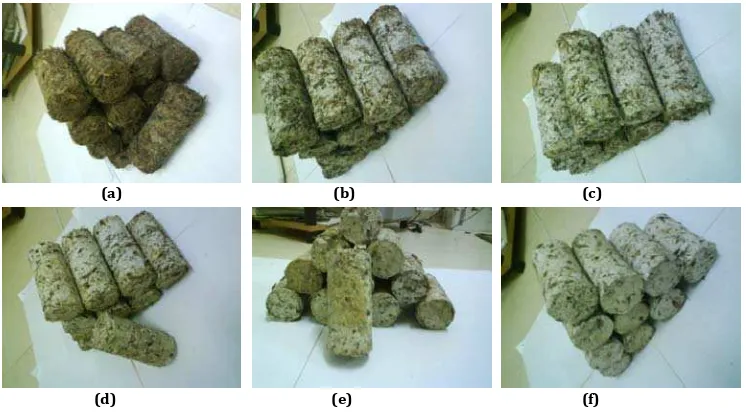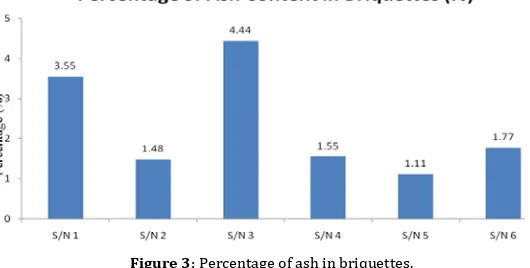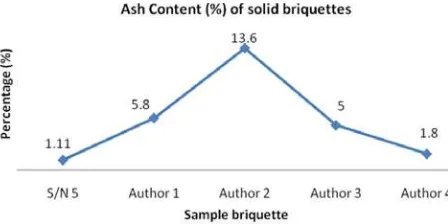YU(AZR) , M.Y., (AERY)P S)(OMB)NG , YA(AYA , S.(., SA)D , M.R., UMAR N)RMAL , SA)JOD LAU and P(ONGSAKORN PRAK TOM
1, 2, 3
Faculty of Manufacturing Engineering
4
Faculty of Mechanical Engineering Universiti Teknikal Malaysia Melaka
Hang Tuah Jaya, 76100 Durian Tunggal, Melaka, MALAYSIA
1
2
iphaery@ utem.edu.my
5, 6
Faculty of Engineering and Technology Multimedia University
Jalan Ayer Keroh Lama, 75450, Melaka, MALAYSIA
3
4
7
Nuclear Power Division Malaysia Nuclear Agency Bangi, 43000, Kajang, MALAYSIA
5
1.0 INTRODUCTION
Producing energy from renewable biomass is only one of the various ways of responding to the challenges of the
energy crisis. Since the oil crisis in ’s the use of biomass as a source of energy is a topic of growing interest
and debate as agreed by Gómez-Loscos , Tong and Li , Arias , Vaclav , Fernando
, Kaygusuz and Keles .
Corley and Tinker in their book discuss in detail about oil palm in Malaysia. )n , Malaysia had
about . million hectares of land under oil palm cultivation. Currently, more than percent of the oil palm produced is used for food applications like cooking oil, frying oil and many others. Oil palm is a perennial crop. )t has an economic life span of about years. Traditionally, oil palm is grown for its oil example like palm oil, palm kernel oil, and palm kernel cake as the community products. Besides palm oil and palm kernel, oil palm industry generates large quantity of biomass residue which is side products as stated before like fronds, trunks, EFB, palm oil mill effluent, palm fibre and shell that have not been fully commercially exploited.
Through concerted research and development efforts by many research organizations including Malaysian Oil Palm Board, this co – products from palm oil industry have been found to be good resources for
many application such as palm oil fuel ash a biomass residue Brown et al., , oil palm as a viable concrete
pozzalanic material Foo and (ameed, , Oil palm ash as partial replacement of cement for
solidification/stabilization of nickel hydroxide sludge Chun et al., , oil palm ash in concrete Tangchirapat
et al., .There are many competitive uses of these materials. One of them is to utilize them as a fuel for ABSTRACT
This research discussed on the results obtained for each sample that have been conducted to the solid fuel briquettes made of empty fruit bunch fiber and waste papers from view of ash content during combustion test. The results shows tremendous amount of ash content can be generated from these biomass compositions. Percentage of ash content in every composition is important to know how much ash produced every burning process because this is really related to environmental issues (human and equipment, i.e hygiene). Hence, the possibility result in this research is the development of solid fuel briquette by mixing the empty fruit bunch with a waste paper can be one sources of fuel energy. From the combustion analysis shows sample briquette of S/N 5 was found to be the best ratio as the amount of ash produced at the end of combustion process is the least compared to others researcher with a value of 1.11 percent.
Keywords: Empty Fruit Bunch Fiber, Waste Papers, Ash Content.
energy production but in term of biodiesel fuel. )n fact, Malaysian government has identified biomass as fifth fuel resource to compliment the petroleum, gas, coal, and hydro as energy resources, while palm biomass has been
identified as a single most important energy source as stated by Sumiani . On the other hands, the main
sources of biomass in Malaysia are domestic wastes, agricultural wastes, effluent sludge and wood chips
Yuhazri et al., and Yuhazri et al., .
Biomass energy systems can be based on a wide range of feedstock like food and garden wastes Romeela
and Ackmez, , solid wastes and sewage sludge Despina et al., , cellulosic ethanol Gonzalez, ,
coal and cattle biomass Carlin et al., and many more. They use many different conversion technologies to
produce solid, liquid, and gaseous fuels. These can then be used to provide heat, electricity and fuels to power vehicles; using burners, boilers, generators, internal combustion engines, turbine or fuel cells. Power can be generated by co – firing a small portion of biomass on existing power plant, burning biomass in conventional steam boilers, biomass gasification and anaerobic digestion.
Converting palm biomass into a uniform and solid fuel through briquetting process appears to be an
attractive solution in upgrading its properties and add value as reported by Sławomir, , De et al., ,
Nasrin et al., , Chuen-Shii, . Biomass briquette is the process of converting low bulk density
biomass into high density and energy concentrated fuel briquettes. Biomass briquette plant is of various sizes which converts biomass into a solid fuel. Briquettes are ready substitute of coal or wood in industrial boiler and brick kiln for thermal application. Biomass briquettes are non conventional source of energy, renewable in nature, eco – friendly, non polluting and economical. Process of converting biomass into solid fuel is non polluting process. )t involves drying, cutting, grinding, and pressing with or without the aid of a binder.
Malaysia has involved in palm oil industry over the last four decades and since then it has generated vast quantities of palm biomass, mainly from milling and crushing palm kernel. Empty fruit bunch is the main solid waste from oil palm obtained from milling process. This biomass can be used as an alternative energy for combustion purposes especially in industry. Unfortunately, due to its poor physical properties EFB is not normally utilized as fuel. (owever, it can be use in optimise by upgrading and treating its properties. The method that can be used is the briquetting technique. Briquetting is the alternative method in upgrading biomass into a useful solid fuel that can be done through various technologies. )n this research, EFB material will be mixed up with the recycled papers and it will be turned into solid briquette through the briquetting process. The used of recycle papers in this research is to utilized the abundant papers into something useful, thus helps in reducing the number of municipal wastes generated every year. Papers are selected as a material to be used compared to the other types of recycled wastes such as glass and plastic because it is known to be a good material for a combustion ignition. As for plastics, it may be compatible to papers to be used as ignition material in combustion, but it will spread a toxic gas while it is burn.
The scope of this research is mainly focusing on the mixing of the empty fruit bunch, EFB and the recycled papers. All these palm oil mills is to be obtained, mixed up and to be develop as a fuel briquette at a certain ratio or percentage with the EFB as the major element. This fuel briquette is to be carried out with the performance
tests and comparison tests in terms of its calorific values Yuhazri et al., a , gas emission Yuhazri et al.,
b , stability and durability, proximate, ultimate, immerse and crack, but in this paper part only discuss on ash content produced after combustion test.
2.0 MATERIALS AND METHODS
Empty Fruit Bunch EFB supplied by Malaysian Palm Oil Board MPOB from one of plantation in Malaysia was used as reinforced material in this green composites fabrication. The EFB used in the composites was in a chopped strand form. The EFB type used was shown in the Figure a and the Table is the basic properties of
EFB used for the fabrication of the composites based on study done by Nasrin et al., .
(a) (b)
Recycled papers are use as a matrix material in the solid fuel briquette fabrication. The reason to choose papers as recycled waste in this research is because due to the properties of papers which can provide good properties for combustion. Furthermore, it can act as a binder during the blending of papers and EFB during fabrication stage. The papers are obtained from waste papers of the paper shredder machine. This is because the crushing papers have a standard size and dimension after is shredded inside the crushing machine. The standard size and dimension helps to ensure that the blending of papers and EFB is uniform.
Table 1: Properties of EFB as raw materials. Nasrin et al.,
Raw Material Average size of Materials Calorific Value Moisture Content Ash Content kJ/kg % %
Pulverized EFB < µm . .
EFB Fibre cm . .
EFB Fibre . mm . .
The dimension of sample briquette produced during sample preparation is mm in diameter and mm in length with average weight about . grams. The ratio of briquette produced is presented in Table and Figure is actual specimens.
Table 2: Sample ratio and its serial number
Ratio of EFB to Paper Serial Number
: S/N : S/N : S/N : S/N : S/N : S/N
There are several steps involved in producing a single briquette according to its ratio. Firstly, the waste papers need to be immersed in water for hours and then it is blended using a blender to mash up the waste papers. Then, the blended papers it weighed again to get the weight of mashed papers with water. After dividing the EFB and shredded papers according to their ratios, the EFB fiber is mixed up with the shredded paper. Then, the compacting step takes place by compacting the mixing of EFB and waste paper into a solid briquette by using
hydraulic press machine and cylinder mold. The size of the mold is mm in length and mm in diameter.
The mixing is compressed into the mold until it gets to the desired length which is mm. The amount of pressure applied during compacting process is bars. Finally, the solid briquette is placed inside a drying oven
at temperature °C for hours to remove the water obtained during the compacting process.
(a) (b) (c)
(d) (e) (f)
3.0 RESULTS AND DISCUSSION
From the combustion test, the amount of ash produced from the combustion of each briquette can be obtained. )t can be done by taking the residue from the sample that has burnt completely and weighed it using a digital weight scale. The percentage of ash content produce for each briquette can be calculated. The percentage of ash content of solid briquette for each ratio is represented in a Table .
Table 3: Ash content and percentage of ash for sample briquettes
Ratio of EFB to paper Mass of Briquette (g) Ash content (g) Percentage of Ash (%)
S/N . . . S/N . . . S/N . . . S/N . . . S/N . . . S/N . . .
The sample briquette S/N produced the least amount of ash as a result of the combustion process test. This is followed by a sample briquette S/N with percentage of ash content is . %. Sample briquette S/N produced the largest amount of ash content which is . % and followed by sample briquette S/N with percentage of . %. This value can be further represent by a graphical form in Figure .
Figure 3: Percentage of ash in briquettes.
Figure shows the gap between briquettes with the highest ash content with a briquette with the lowest ash content is . percent. A good and quality briquette in terms of combustion efficiency is the least amount of ash content produced after combustion process. This shown that the briquette is burning effectively causing the ash produced at the end of the combustion process is small. From the experiment, the higher amount of waste paper in the ratio, the smaller the amount of ash produced at the end of the combustion process. This is because, paper will get burnt easily and it will burn completely first leaving the EFB that sustained the burning of the briquettes. Briquettes with the largest amount of EFB will produce greater amount of ash at the end of the combustion process. This is proven by the experimental work conducted which shown that S/N and S/N produced the highest amount of ash content compared to others. Similar to the combustion analysis conducted
byNasrin et al., , % EFB briquette produced the highest amount of ash content compared to other
briquettes tested. The authors also discussed on the comparison of the ash content produced by the EFB in two different conditions which one is in fibre form and the other one is in powder form. )t is shown that EFB in fibre form will produce greater ash content compared to EFB in powder form at the end of combustion process.
Obernberger and Thek , also stated that in order to maintain a high operating comfort for end users in the
residential heating sector, a high ash content must be avoided. This is due to the possibility of increasing danger of slag and deposit formation in the furnace as well as the rising of dust emission. (igh percentage of ash content implied that fiber could only burnt satisfactorily in a limited range of coal appliances for example step furnace. (igh ash content is likely to reduce the ignitability of fuel briquettes which in contrast to fuel property that should be combustible and easy to ignite. Mass losses over specific temperature ranges in a specific atmosphere provide a compositional analysis of that substance. Figure illustrated the comparison of ash content on sample
Figure 4: Percentage of ash in sample briquettes
Based on the Figure , it is proven that the ash content of the fuel briquette form S/N and S/N are relatively lower compared to the sample briquettes produced by the author at the same ratio. The author is conducting a sample briquette of EFB and sawdust at several ratios. The different between the ash content from
S/N with the author sample briquette of EFB : S is . percent whereby the different in percentage of
ash produced for sample briquette S/N with sample briquette of EFB : S is . percent. This has
clearly shown that the sample briquette S/N and S/N produced are better compared to the sample briquettes produced by the author. Another comparison can be made with the other researchers that have conducted the study on the same field which is production of solid briquettes by referring the Table .
Table 4: Comparison of ash content %
No Authors Title of study Ash content (%)
(usain et al. Briquetting of palm fiber and shell. .
Demirbas and Sahin Briquetting of waste paper and wheat straw .
Yaman et al. Production of briquettes form olive refuse and paper mill waste .
Nik Farah Nik Zulkifli Development of fuel briquettes from Oil Palm Trunk .
Table shows the percentage of ash content in fuel briquette for several researches on biomass briquettes. Based from the table, the least amount of ash obtained from the briquettes from those researchers is higher compared to the palm briquettes that have been studied now. The comparison for the ash content of the sample briquettes produced with the other researchers can be further represented by Figure .
Figure 5: Comparison of briquette S/N with other journal
Referring to Figure , it is shown that sample briquette S/N gives a better percentage of ash content compared to other briquettes from other researchers. The difference may be due to the mass and density of the briquettes produced which vary with the other researchers. Sample briquettes that gives the second best percentage of ash content is from the author which studied on the development of fuel briquette form oil palm trunk OPT . The different if ash content for this author and S/N is . percent. The difference is smaller compared to the different of percentage of ash content of sample S/N with author which is . %. The reason for the large gap may be due to the compositional of the raw material used for the briquettes.
4.0 CONCLUSION
gives the best properties in terms of burning time of the briquette and sample S/N is the best ratio as it
released the highest value of heat released from the combustion process with a value of . kJ. As for the ash
content, sample S/N was found to be the best ratio as the amount of ash produced at the end of combustion process is the least compared to others with a value of . percent. )n the nutshells it can be summarized that all samples briquettes have their own strength and weakness when they were subjected to different types of testing, but still all the briquettes were compatible with each others and it is suitable to be commercialized as a new solid fuel sources that can be utilized in many application such as camping, barbeque and for residence utilization energy. The blending of EFB fiber with waste paper can improve its physical, mechanical, and combustion properties.
REFERENCES
[ ] Arias, N.C. : Production of Biomass From Short Rotation Coppice for Energy Use: Comparison
Between Sweden and Spain, Master thesis at Department of Energy and Technology, Faculty of Natural Resources and Agricultural Science, Swedish University of Agricultural Science.
[ ] Brown, O.R., Yusof, M.B.B.M., Salim, M.R.B. and Ahmed, K. : Physico-chemical Properties of Palm Oil
Fuel Ash As Composite Sorbent in Kaolin Clay Landfill Liner System. Clean Energy and Technology (CET),
2011 IEEE First Conference June , pp. - , - .
[ ] Carlin N.T., Annamalai, K., Oh, (., Ariza, G.G., Lawrence, B., Arcot V.U., Sweeten, J.M., (eflin, K. and (arman,
W.L. : Co-Combustion and Gasification of Coal And Cattle Biomass: A Review of Research and
Experimentation Green Energy - Progress in Green Energy. Springer London Publisher. Vol. , pp. - .
[ ] Chuen-Shii, C., Sheau-(orng, L., Chun-Chieh, P., Wen-Chung, L. : The Optimum Conditions for
Preparing Solid Fuel Briquette of Rice Straw by a Piston-Mold Process Using the Taguchi Method. Fuel
Processing Technology, Vol. , )ss. – , pp. - .
[ ] Chun, Y.Y., Shabuddin, W.W.A. and Ying, P.L. : Oil Palm Ash as Partial Replacement of Cement for
Solidification/Stabilization of Nickel (ydroxide Sludge. Journal of Hazardous Materials, Vol. , )ss. ,
pp. - .
[ ] Corley, R.(.V. and Tinker, P.B.(. : The Oil Palm: World Agriculture Series. Edition . John Wiley &
Sons.
[ ] De, Y.T., Xu, W. and Ai, (.X. : Virtual Design and Simulation for Biomass Plane-die Briquetting
Machine. Advanced Material Research (Renewable and Sustainable Energy). vols. - , pp. - .
[ ] Demirbas, A. and Sahin, A. : Evaluation of Biomass Residue: Briquetting waste Paper and Wheat
Straw Mixtures. Journal of Fuel Processing Technology. pp. – .
[ ] Despina, V., Evaggelia, K., Stelios, S. and Piero, S. :Gasification of Waste Biomass Chars by Carbon
Dioxide via Thermogravimetry : Effect of Catalysts. Combustion Science and Technology. Vol. , )ss. ,
pp. - .
[ ] Fernando Galembeck : Synergy in Food, Fuels and Materials Production from Biomass. Energy
Environ. Sci., vol. , iss. , pp. - .
[ ] Foo, K.Y. and (ameed, B.(. : Value-Added Utilization Of Oil Palm Ash: A Superior Recycling Of The
)ndustrial Agricultural Waste. Journal of Hazardous Materials, Vol. , )ss. – , pp. - .
[ ] Gómez-Loscos, A., María, D.G. and Montañés, A. : Economic Growth, )nflation and Oil Shocks: Are the
s Coming Back?. Applied Economics, Vol. , )ss. , pp. - .
[ ] Gonzalez, R.W. : Biomass Supply Chain and Conversion Economics of Cellulosic Ethanol. Ph.D. Thesis
at North Carolina State University. USA.
[ ] (usain, Z., Zainac, Z. and Abdullah, Z. : Briquetting of Palm Fibre and Shell from the Processing of
Palm Nuts to Palm Oil. Journal of Biomass and Bioenergy, pp. – .
[ ] Kaygusuz, K. and Keleş, S. : Use of Biomass as a Transitional Strategy to a Sustainable and Clean
Energy System. Energy Sources,Part A: Recovery, Utilization, and Environmental Effects, Vol. , )ss. , pp.
-.
[ ] Nasrin, A.B., Choo, Y.M., Lim, W.S., Joseph, L., Michael, S., Rohaya, M.(. and Astimar, A.A. : Briquetting
of Empty Fruit Bunch Fibre and Palm Shell as a Renewable Energy Fuel. Journal of Engineering and Applied
Sciences, Vol. , No. , pp. - .
[ ] Nasrin, A.B., Ma, A.N., Choo, Y.M., Mohamad, S., Rohaya, M.(., Azali, A. and Zainal, Z. : Oil Palm
Biomass as Potential Subtituition Raw Materials for Commercial Biomass Briquettes Production. American
Journal of Applied Sciences.
[ ] Nik Farah Nik Zulkifli : Development of Fuel Briquettes from Oil Palm Trunk. Final Year Thesis
at UiTM. Malaysia.
[ ] Obernberger, ). and Thek, G. : Physical Characterization and Chemical Composition of Densified
[ ] Romeela, M. and Ackmez, M. : Energy from Biomass in Mauritius: Overview of Research and
Applications, Waste to Energy . Springer London Publisher. )SBN: - - - - .
[ ] Sławomir, O. : Analysis of Usability of Potato Pulp as Solid Fuel, Fuel Processing Technology, Vol. ,
)ss. , pp. - .
[ ] Sumiani, Y. : Renewable Energy From Palm Oil – )nnovation on Effective Utilization of Waste. Journal
of Cleaner Production, Vol. , )ss. , pp. - .
[ ] Tangchirapat, W., Saeting, T., Jaturapitakkul, C., Kiattikomol, K. and Siripanichgorn, A. : Use of Waste
Ash From Palm Oil )ndustry )n Concrete. Waste Management, vol. , pp. – .
[ ] Tong, Z. and Feng, T. : A Study On Energy Saving of LEED-NC Green Building Rating System From
Point Analysis. Advanced Materials Research, Vols. - , pp. - .
[ ] Vaclav, S. : Energy Myths and Realities: Bringing Science to the Energy Policy Debate. Government
)nstitutes Publisher.
[ ] Yaman, S., Sahan, M.S., (aykiri, M.(., Sesen, K., Ku’’c,u’’kbayrak, S., : Production Of Fuel Briquettes
From Olive Refuse And Paper Mill Waste. Journal of Fuel Processing Technology. pp. - .
[ ] Yuhazri, M.Y., Sihombing, (., Jeefferie, A.R., Ahmad Mujahid, A.Z., Balamurugan, A.G., Norazman, M.N. and
Shohaimi, A. : Optimazation of Coconut Fibers Toward (eat )nsulator Applications. Global Engineers
& Technologists Review, Vol. , No. , pp. - .
[ ] Yuhazri, M.Y., Kamarul, A.M., (aeryip Sihombing, Jeefferie, A.R., (aidir, M.M., Toibah, A.R. and Rahimah, A.(. : The Potential of Agriculture Waste Material for Noise )nsulator Application Toward Green Design
and Material, International Journal of Civil & Environmental Engineering, Vol. , No. , pp. - .
[ ] Yuhazri, M.Y., (aeryip Sihombing, Umar, N., Saijod, L. and Phongsakorn, P.T. a : Solid Fuel from Empty
Fruit Bunch Fiber and Waste Papers Part : (eat Released from Combustion Test, Global Engineers and
Technologists Review, Vol. , No. , pp. - .
[ ] Yuhazri, M.Y., (aeryip Sihombing, Yahaya, S.(., Said, M.R., Umar, N., Saijod, L. and Phongsakorn, P.T. b : Solid Fuel from Empty Fruit Bunch Fiber and Waste Papers Part : Gas Emission from Combustion



